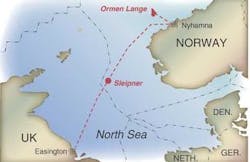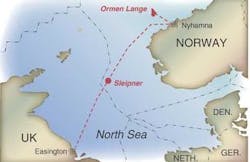New trunklines lined up, following accord
Jeremy Beckman • London
Two of the North Sea's most prized pipelay contracts in years have gone to Allseas Marine Contractors and Stolt Offshore. Both relate to Ormen Lange, Europe's largest offshore gas field, with reserves estimated at 390 bcm.
A recent accord signed by the governments of Norway and Britain paved the way for gas exports from this and other Norwegian fields to the UK mainland via a series of new trans-North Sea pipelines.
Approval for the Ormen Lange development is still pending from the Norwegian Energy Ministry. But assuming work schedules go to plan, the main trunkline and associated pipelines will be laid during 2005-06, with first supplies feeding through by October 2007. The subsea trunkline, at 1,200 km, will also be the world's largest. At peak, the system will send 20 bcm/yr to a terminal at Easington, eastern England, representing close to 20% of the UK's gas demand. Norsk Hydro will operate the development phase; Norwegian pipeline authority Gassco will take over during production.
null
Stolt has been asked to lay the 540-km, 44-in. section extending from the tie-in point (Statoil's Sleipner riser platform) southwest to Easington. Work will be performed by the LB 200 lay barge, which used to be a regular in the North Sea until dwindling opportunities forced relocation to West Africa and the Gulf of Mexico. Stolt also has an option for the 362-km, 42-in. stretch from a proposed new gas reception terminal at Nyhamna on Norway's west coast to Sleipner. Part of this line must cross the treacherously sloping and rocky Norwegian trench to Sleipner.
Allseas will lay two 30-in. lines (33 km in total) and a section of 42-in. line near shore to Nyhamna. It also has options to install part of the Nyhamna-Sleipner 42-in. line. Total value of these two contracts is $500 million. Earlier, Europipe and Mitsui/Sumitomo clinched $700 million of orders for the line pipe steel. Ormen Lange lies 100 km offshore in water depths ranging from 800 m to 1,100 m.
Following the bilateral agreement between the two governments, the Statfjord partners Statoil, Shell, and Esso have also made provisional plans to ship wet gas from this field to the St Fergus terminal, north of Aberdeen. Assuming approval for the Statfjord late life/redevelopment plan (expected end-2004 or early 2005), supplies from the field could be shipped from 2007 onwards through a new 20-km line connecting to the Shell/Esso owned Flags export system at one of the Brent platforms. On arrival at St Fergus, dried gas would feed through into the UK's grid. Stripped out NGLs – propane and naphtha – would be transported south to Fife for use as LPG or as ethylene feedstock. Flags is also thought to have spare capacity for further imports of gas from other Norwegian fields.
Vigdis upgraded
Recoverable oil from the Vigdis extension development in the North Sea has been revised upwards to 60 MMbbl by operator Statoil. This follows completion of the first two production wells last month. The NKr 2.6-billion project came onstream in October, two months ahead of schedule, as a subsea tieback to the Snorre A platform. Four more wells are due to be drilled, all grouped via seabed templates. Thanks to a combination of subsurface mapping techniques and optimized well placement and drainage, Statoil also foresees a recovery factor of 60%, higher than its usual return for subsea schemes. Improving subsea yield happens to figure highly in Statoil's newly declared North Sea strategy.
The company also has a small but seemingly commercial discovery with an exploration well drilled south from the Gullfaks B platform. The well found gas and condensate in Late Cretaceous sandstones. Elsewhere on the Norwegian shelf, Norsk Hydro has submitted a plan to develop the Oseberg West flank via subsea facilities from the Oseberg complex. It is also targeting an additional 100 MMbbl from Oseberg, Brage, and Njord through a series of new efficiency measures. Closer to the UK median line, Marathon is expected to outline development plans shortly for its recent oil and gas discoveries in the Heimdal area.
New UK intake drops out
In the UK sector, small independents come and go. London-based Consort Resources, at one point seen as a possible savior of the UK southern gas basin, recently sold itself and operated holdings in undeveloped fields on the Dutch/UK median line to Caledonia Oil & Gas. More unexpected was DNO's decision to sell most of its North Sea properties to Sweden's Lundin Petroleum for $165 million. These included modest interests in various Norwegian fields, including Marathon's around Heimdal, and 12.5% of Ramco's producing Seven Heads gas field off southern Ireland, through DNO's subsidiary Island Petroleum. But the main assets in terms of current production were those operated by DNO Britain in Aberdeen, namely the Heather field. It has been painstakingly revitalized by this company over the past six years. Also included were the associated Broom subsea development, and the recently acquired Thistle platform.
Mid-scale independents remain more committed. Talisman notched another oil discovery within easy reach of its Buchan platform in the Outer Moray Firth, on the J5 prospect. The well, in block 21/1a, tested 7,100 b/d of 40° API crude and 76 MMcf/d of gas in Upper Jurassic sandstones. It could be developed jointly with the 2002 J1 discovery. Talisman puts combined reserves from the two fields at 50-100 MMbbl. Farther north, Kerr-McGee, has found new oil with a well on the Affleck prospect, and was expected to test a second zone prior to sidetracking the well. Kerr-McGee's Janice FPU is stationed 24 km distant.
Ukooa warns of pitfalls ahead
Britain's government should step up its efforts to foster commercial and political relationships with more gas exporting countries, according to the UK Offshore Operators Association in a new paper. More needs to be done, Ukooa says, to guarantee security of gas supply long-term, both through construction of new subsea pipeline connector links to mainland Europe and through investment in Britain's National Transmission System.
Among the main points raised are:
- The need to maximize recovery of UKCS reserves to prolong self-sufficiency – additional taxation or ill-considered regulation could discourage the required investment
- New sources of gas supply will be needed after 2006-07, and new gas import facilities should be built in readiness
- LNG will play an increasingly influential part in Britains energy mix – new reception terminals are planned in southeast England and southwest Wales
- New gas storage facilities should be considered, as declining UKCS fields will no longer fulfill the required supply swing capability.
Ukooa is also deeply concerned over the potential impact on Britain's oil and gas industry of the European Union's proposed "Energy Chapter." Any attempt at increased regulation by Brussels could threaten the recent revival in investment by North American and European independents, the association believes. However, after publicizing these concerns, in the form of a letter to Britain's Prime Minister, Ukooa subsequently adopted a lower key stance, pending the outcome of discussions with the government. Further developments were expected at the end of November.

